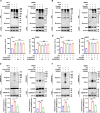NU6300 covalently reacts with cysteine-191 of gasdermin D to block its cleavage and palmitoylation
- PMID: 38324683
- PMCID: PMC10849585
- DOI: 10.1126/sciadv.adi9284
NU6300 covalently reacts with cysteine-191 of gasdermin D to block its cleavage and palmitoylation
Abstract
Gasdermin D (GSDMD) serves as a vital mediator of inflammasome-driven pyroptosis. In our study, we have identified NU6300 as a specific GSDMD inhibitor that covalently interacts with cysteine-191 of GSDMD, effectively blocking its cleavage while not affecting earlier steps such as ASC oligomerization and caspase-1 processing in AIM2- and NLRC4-mediated inflammation. On the contrary, NU6300 robustly inhibits these earlier steps in NLRP3 inflammasome, confirming a unique feedback inhibition effect in the NLRP3-GSDMD pathway upon GSDMD targeting. Our study reveals a previously undefined mechanism of GSDMD inhibitors: NU6300 impairs the palmitoylation of both full-length and N-terminal GSDMD, impeding the membrane localization and oligomerization of N-terminal GSDMD. In vivo studies further demonstrate the efficacy of NU6300 in ameliorating dextran sodium sulfate-induced colitis and improving survival in lipopolysaccharide-induced sepsis. Overall, these findings highlight the potential of NU6300 as a promising lead compound for the treatment of inflammatory diseases.
Figures








References
-
- Shi J. J., Zhao Y., Wang K., Shi X. Y., Wang Y., Huang H. W., Zhuang Y. H., Cai T., Wang F. C., Shao F., Cleavage of GSDMD by inflammatory caspases determines pyroptotic cell death. Nature 526, 660–665 (2015). - PubMed
-
- Feng S., Fox D., Man S. M., Mechanisms of gasdermin family members in inflammasome signaling and cell death. J. Mol. Biol. 430, 3068–3080 (2018). - PubMed
-
- Ding J. J., Wang K., Liu W., She Y., Sun Q., Shi J. J., Sun H. Z., Wang D. C., Shao F., Pore-forming activity and structural autoinhibition of the gasdermin family. Nature 535, 111–116 (2016). - PubMed
-
- A. Balasubramanian, L. Ghimire, A. Y. Hsu, H. Kambara, X. Liu, T. Hasegawa, R. Xu, M. Tahir, H. Yu, J. Lieberman, H. R. Luo, Palmitoylation of gasdermin D directs its membrane translocation and pore formation in pyroptosis. bioRxiv 2023.02.21.529402 [Preprint] (2023). 10.1101/2023.02.21.529402. - DOI
Publication types
MeSH terms
Substances
LinkOut - more resources
Full Text Sources
Molecular Biology Databases
Miscellaneous

